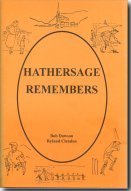Review of ‘Hathersage Remembers’, by Bob Dawson and Ryland ClendonThis review is by Julie Bunting, and was published originally in The Peak Advertiser, the Peak District's local free newspaper, on 17th July 2000, and is reproduced with Julie's kind permission.
Another resident still lives in the house in the Dale where she was born in 1911, sharing two bedrooms with her parents and five brothers and sisters. There were eight children next door too where mother and father 'always had a baby'. At one time fifty-four children walked down to school from the twelve mill cottages on The Hill, built well above the smoke rising from the village manufactories. Being related in the first person, lost pleasures really come to life. Cycling to Castleton to search for Blue John on the hillside; a lantern-slide lecture given at the Memorial Hall by 'Grey Owl', not quite the full-blooded American Indian he claimed to be; the regular Friday sheep market next to the George Hotel, with horses and cows also sold on Fair Day, when there were stalls all down the main street and a fairground driven by steam engines. And the happy day when the headmaster burnt the punishment canes. On darker days there was whooping cough, alleviated by the miraculous water from Leveret Well; a childhood brush with death on trying out this new-fangled electricity at bath-time; bombs landing in Hathersage during the Sheffield blitz; then a peep at lines of soldiers, just evacuated from Dunkirk, asleep inside the Station Hotel, now the Little John. Lost shops are mourned: 'Ticker' Marshall the watch and clock repairer; Bannerman's bakers with the ghostly flour-ingrained proprietor; the 'Work Basket' where May Darwent refused to use decimal currency but continued with old shillings and pence; and Rastalls' greengrocers who delivered by horse and cart. Gone too are the days of Hathersage telephone exchange and three-digit telephone numbers, with an operator who could put you through to the bank or Hancock's shop without asking the number. Clubs and societies have always flourished in Hathersage and clearly add much to its unity, the Millennium Group proving the point. So much is catered for, from swimming and bowls to handbell ringing, amateur dramatics and the 'Girls' who sing for their supper. However, the book ends with a thought-provoking Incomer's Tale which looks at the price of living in a 'honeypot'. Hathersage Remembers is published in aid of other Hathersage Millennium projects and printed by Valley Printers of Hathersage. Review by Julie Bunting Editor's Note: |
|||
